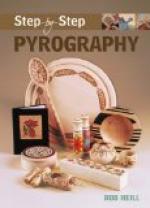The most serious trouble Brother Basil had in his work was that many of the materials he needed could not be had in Ireland, nor could the Abbey afford to send for them except in very small quantities. The monks were rich compared with most other folk about them. They had food and drink and warm clothing and well-built houses, and productive land. But as yet they could not sell much of their produce at a profit which would make them rich in money. Brother Basil therefore manufactured all the colors he could, from the resources at hand. To make blue, he pounded up a piece of an old stone he had brought from Canterbury. Gilding was done by making gold-leaf out of real gold. The Tyrian purple was made from a gastropod of the seas near Byzantium, and a little snail-like mollusk of Ireland would serve to make a crimson like it. Thinning it, the painter could make pink. There was no vermilion to be had, and red lead must be used for that color and made by roasting white lead. The white lead was prepared by putting sheets of lead in vats of grape skins when the wine had been crushed out of them. Copper soaked in fermenting grape skins would make green, saffron made it a yellower green,—and saffron was grown on the Abbey land—cedar balsam would make it more transparent. Brother Basil was always trying experiments. He was always glad to see a new plant or mineral which might possibly give him a new color.
In all this Padraig was extremely useful. He made friends with a smith who had a forge and furnace miles away, and wheedled him into lending them the furnace for the roasting of metals. He ranged the woods and cliffs all around the Abbey in search of plants, shrubs, trees and minerals. His knowledge of the country saved Brother Basil many a weary tramp, and he always took Padraig with him when he went looking for any especial thing that was needed.
It was some time, however, before Padraig learned what Brother Basil needed most of all. Now that the work of the scriptorium was coming to be known, orders were received for splendidly illuminated missals and other volumes, for which gilding was necessary. The brilliant colors would lose half their beauty without the decorative touches of gilding to set them off. And gold was costly.
“Where do men get gold?” Padraig asked one day.
“Out of the earth,” answered Brother Basil absently.
“I mean,” said Padraig hesitating, “what is it like when it is in the earth? Is it a different color—like copper?” Copper, he knew, was often green when it was found.
“Gold is always gold,” said Brother Basil, coming out of his fit of dreamy abstraction. “I have seen it washed out of rivers. Gold is heavier than gravel, and when the river carries the gold with the earth down from the mountains, the gold sinks to the bottom.”
Padraig said no more, but a day or two later he was missing. The Abbot was not pleased, for now he would have to take a man from other work to do what the boy had been doing. Brother Basil was surprised and hurt. He had never had such a pupil, and had begun to hope that they might always work together for the love of the work and the glory of their Church.




